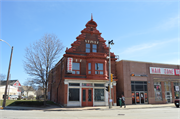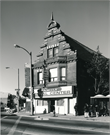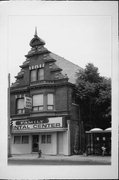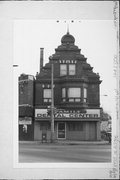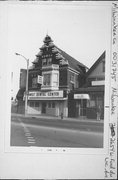| Additional Information: | A 'site file' exists for this property. It contains additional information such as correspondence, newspaper clippings, or historical information. It is a public record and may be viewed in person at the Wisconsin Historical Society, Division of Historic Preservation. Van Ells occupied this structure until 1920. Thereafter the structure was occupied by the Edmund C. Neumann Pharmacy until 1945 to be followed by Hugo Bohn into the 1950s. In 1979, the building was purchased by Dr. Neil Maguire, who operates the associated business of Family Dental.
Henry van Ells, a Dutch-immigrant druggist, plied his trade in a building that is a charming evocation of the Renaissance Revival style known in the low countries. The stepped front gable, finished with flamboyant scrollwork, is the style’s principal hallmark, which embellishes the tall, narrow, front-gabled houses and commercial buildings crowded along the streets and canals of prosperous mercantile cities in the region.
Some have said that van Ells's storefront was patterned after the famous Butchers Hall built in 1603 in Haarlem, the Netherlands. Architects Leiser and Holst also may have found inspiration in countless other Dutch or Flemish buildings. The structure housed a pharmacy until 1979, when its newly remodeled interior and first-floor facade accommodated the Family Dental Center.
"The Van Ells Drug Store is a fine example of a small ethnic commercial building designed in the exuberant Flemish Renaissance Revival style. The flamboyant, step-like front gable with its fine ornamental scrollwork is the principal hallmark of that style.
Flemish Renaissance architecture developed in the early 16th century is a region of Europe known as Flanders, which is now spread over parts of northeastern France and Belgium. Historically, Flanders was closely associated with the Netherlands, which is also known as Holland. Henry Van Ells, for whom this building was constructed, was a Dutch immigrant from Holland and the architecture of his building undoubtedly reminded him of his homeland.
The Netherlands was the cradle of Northern European Renaissance style art and architecture during the 16th and 17th centuries. The term "Renaissance" refers to the period when architecture and art turned away from the Gothic tradition and began to imitate the architectural and artistic ideals or ancient Rome. The scrolled gable was not a form borrowed directly from ancient classical architecture, but it nevertheless became the most characteristic feature of Northern European Renaissance style architecture. The scrolled gable quickly became a highly influential design motif throughout northern Germany and Poland as well. The Van Ells Drug Store is patterned after the Butchers Hall of 1603 in Haarlem, the Netherlands, one of the most famous Flemish Renaissance style buildings in the world.
Henry Van Ellis started his career in Milwaukee as a South Side pharmacist as the Hassinger and Van Ells Drug store on W. Forest Home Ave. in 1892. By the late 1890s he had his own store in the heart of a bustling South Side business district at S. 6th and W. Mitchell Streets. His success at that location enabled him to make his final move to this fine structure at the busy, 6-point intersection of W. Fond du Lac Ave., W. Center St. and N. 27th St.
Van Ells lived above the store in the large shopkeeper's flat through about 1921. A few years after Van Ells moved out, the second floor was remodeled into medical offices. A pharmacy was continuously in business on the first floor of the building until 1979 when the space was remodeled to house the Family Dental Center." MILWAUKEE ETHNIC COMMERCIAL AND PUBLIC BUILDINGS TOUR, CITY OF MILWAUKEE DEPARTMENT OF CITY DEVELOPMENT, 9/1994.
2024 - A period-appropriate storefront has been revealed or recreated |
|---|

